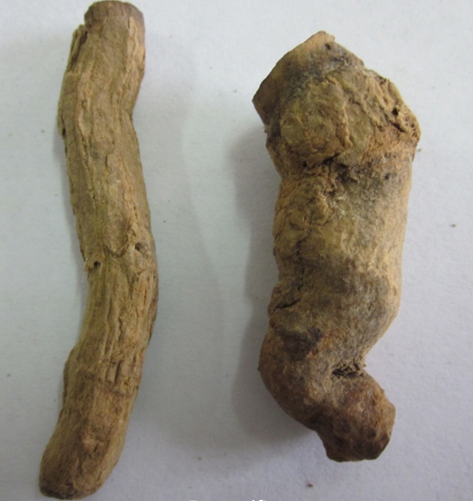Rauwolfia
Source, diagnostic characters, constituents, tests and uses

Objectives
At the end of this lecture, student will be able to
• Discuss the source, diagnostic characters, constituents, tests and uses of Rauwolfia
Rauwolfia
Rauwolfia, also known as Rauvolfia serpentina or Indian snakeroot, is a plant that has been traditionally used in various medicinal and therapeutic applications. Let’s delve into the source, diagnostic characters, constituents, tests, and uses of Rauwolfia:
Synonym
• Indian snake root, Chootachand, Sarpaganda
Biological Source of Rauwolfia
• Rauwolfia is native to the Indian subcontinent and Southeast Asia. It is a perennial shrub that thrives in tropical and subtropical regions. The plant is characterized by its woody stems, simple opposite leaves, and small, fragrant flowers. The roots of Rauwolfia are the primary source of its medicinal properties.
• Dried rhizomes and roots of Rauwolfia serpentina contains not less than 0.15 % of reserpine group of alkaloids, calculated as reserpine
Family
• Apocynaceae
Rauwolfia – Macroscopy
- Leaves: Rauwolfia leaves are simple, opposite, and elliptical in shape. They have a glossy appearance and can vary in size, typically around 7-10 cm in length.
- Flowers: The flowers of Rauwolfia are small, tubular, and white with a sweet fragrance. They are arranged in clusters.
- Roots: The roots of Rauwolfia are thick and tuberous, often twisted and gnarled in appearance. They are the most valued part of the plant for medicinal purposes.
- Fruits: Rauwolfia produces small, red to black, berry-like fruits.
• Size
• Shape
• Colour
• Fracture
• Odour
• Taste
Microscopy of Rauwolfia
• Periderm
1. Cork – Stratified
– Smaller, suberized, unlignified
– Larger, suberized, lignified
2. Phellogen
3. Phelloderm
• Secondary phloem
• Secondary xylem
• Medullary rays
– Xylem region are lignified
– Phloem region are not lignified
• Starch and twin prisms of calcium oxalate
Powder characters of Rauwolfia
Organoleptic characters: Taste, Colour, odour, taste
Active Constituents of Rauwolfia:
• Alkaloids – Indole alkaloids – Nearly 30 (1.5-3%) – root bark
• Phytosterols, fatty acids, unsaturated alcohols, sugars (dextrose, sucrose)
• Indole alkaloids –
Weakly basic indole group
• Reserpine group- Reserpine, Rescinnamine, desperidine
Tertiary indole alkaloids
• Ajmaline group- Ajmaline, ajmalicine
• Serpentine group- Serpentine, serpentinine, alstonine
Chemical tests of Rauwolfia:
- Freshly fractured surface with Conc. Nitric acid- red colour in medullary ray
- Vanillin in acetic acid – Violet colour – Reserpine
- Powder + Sulphuric acid in p-dimethyl amino benzaldehyde – violet to red colour (Indole alkaloids)
- Tincture of drug in UV light – blue fluorescence
Uses of Rauwolfia:
- Antihypertensive Properties: Rauwolfia, specifically its alkaloid reserpine, is known for its ability to lower blood pressure. It has been used in the treatment of hypertension, although modern medicine has largely replaced it with more selective and less sedative drugs.
- Antipsychotic Effects: Reserpine has also been used in the past as an antipsychotic medication, primarily to manage symptoms of mental disorders like schizophrenia. However, due to its sedative side effects, it is rarely used today for this purpose.
- Sedative and Calming Effects: Rauwolfia has mild sedative properties and has been used as a traditional remedy for anxiety, insomnia, and stress.
- Antiarrhythmic Effects: Some compounds in Rauwolfia, such as ajmaline, have antiarrhythmic properties and have been used in the management of irregular heart rhythms.
- Traditional Medicine: In Ayurvedic and traditional Indian medicine, Rauwolfia has been employed for a wide range of ailments, including snakebites, fevers, and digestive issues.
- Research: Rauwolfia and its constituents continue to be subjects of scientific research, exploring potential applications in various medical conditions, including cancer and neurological disorders.
- Treatment of hypertension (Antihypertensive) and in certain neuropsychiatric disorders (Hysteria)
- Treatment of insomnia and certain forms of insanity
- Sedative and transquillizing agent (Reserpine group)
- Ajmaline – pharmacological properties similar to quinidine – cardiac arrhythmias
- Yohimbine – treatment of impotence
Substitutes of Rauwolfia
- R. vomitoria– African rauwolfia – bushy plant/tree, contains bands of sclereids and large vessels
- R. densiflora– absence of stratified cork, sclerenchyma (cortex and phloem)
- R.tetraphylla – Uniform cork (non-stratified), abundant sclereids, absence of recinnamine
Summary of Rauwolfia
- Dried roots ofRauwolfia serpentinawith bark intact, contains not less than 0.15 % of reserpine group of alkaloids, calculated as reserpine Indole alkaloids – Reserpine – antihypertensive, sedative
FAQ
What is Rauwolfia?
Rauwolfia, also known as Rauvolfia serpentina or Indian snakeroot, is a plant native to the Indian subcontinent and Southeast Asia. It is known for its medicinal properties.
What are the main diagnostic characters of Rauwolfia?
The diagnostic characters of Rauwolfia include simple opposite leaves, small fragrant white flowers, tuberous roots, and small berry-like fruits.
What are the active constituents of Rauwolfia?
The primary active constituent of Rauwolfia is reserpine, an alkaloid. Other constituents include ajmaline, serpentine, and yohimbine.
What are the medicinal uses of Rauwolfia?
Rauwolfia has been traditionally used for its antihypertensive properties to lower blood pressure. It has also been used as a mild sedative and in the past as an antipsychotic medication.
Is Rauwolfia still used as a treatment for hypertension?
While Rauwolfia was once used as an antihypertensive medication, modern medicine has largely replaced it with more selective and less sedative drugs. It is rarely used for hypertension today.
Are there any side effects associated with Rauwolfia or its constituents?
Yes, Rauwolfia and its alkaloids, especially reserpine, can have significant side effects, including sedation, depression, and gastrointestinal issues. They should be used under the guidance of a healthcare professional.
Can Rauwolfia be used in traditional medicine practices?
Yes, Rauwolfia has a history of use in traditional medicine, particularly in Ayurvedic practices, for various ailments, including snakebites and digestive issues.
Is Rauwolfia still a subject of scientific research?
Yes, Rauwolfia and its constituents continue to be studied in scientific research for potential applications in various medical conditions, including cancer and neurological disorders.
Are there modern medications with similar effects to Rauwolfia?
Yes, there are modern medications with antihypertensive and sedative effects that are often preferred due to their improved safety profiles and effectiveness.
Is Rauwolfia readily available as a herbal supplement?
Rauwolfia supplements are available in some regions, but it’s important to use them with caution and consult a healthcare professional, as they can interact with other medications and have side effects.
Also, Visit: B. Pharmacy Notes | B. Pharma Notes | Study material Bachelor of Pharmacy



